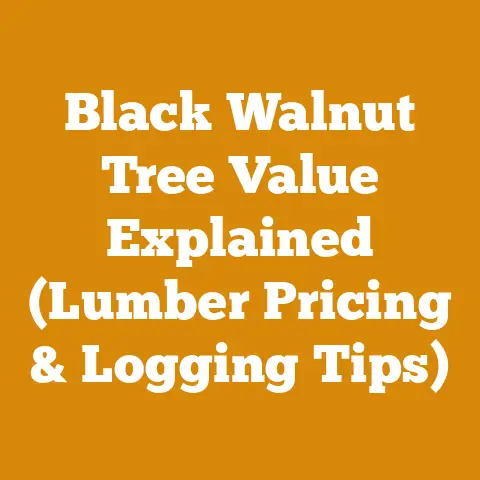Nitrogen Fertilizer for Trees (5 Pro Tips for Healthier Wood)
Nitrogen, my friends, is a powerhouse.
It’s a crucial nutrient that fuels growth, strengthens defenses, and ultimately leads to healthier, more productive trees.
For those of you involved in logging, wood processing, or even just managing your own firewood supply, healthy trees translate to higher quality timber and a more sustainable yield.
Let’s dive into my top five pro tips.
1. Understand the Nitrogen Needs of Your Trees
Before you even think about opening a bag of fertilizer, you need to understand what your trees actually need.
This isn’t a one-size-fits-all situation.
Different species have different nitrogen requirements, and the existing soil conditions play a huge role.
Soil Testing: Your First Line of Defense
I always recommend starting with a soil test.
It’s like getting a check-up for your soil.
I’ve seen so many folks skip this step and end up over-fertilizing or using the wrong type of fertilizer, which can do more harm than good.
- How to do it: You can purchase a soil testing kit online or from your local garden center.
Follow the instructions carefully, collecting samples from several different areas around the base of your trees. - What to look for: The test results will tell you the current nitrogen levels in your soil, as well as the pH level and the presence of other important nutrients.
- My experience: Years ago, I was convinced my maple trees needed a nitrogen boost.
After a soil test, I discovered the soil was already nitrogen-rich, but deficient in phosphorus.
I adjusted my fertilization strategy accordingly, and the trees flourished.
Species-Specific Considerations
Different tree species have varying nitrogen demands.
Fast-growing trees like poplars and willows generally require more nitrogen than slow-growing hardwoods like oaks and beeches.
Conifers like pines and firs often have lower nitrogen needs, especially in acidic soils.
- Research is key: Take the time to research the specific nitrogen requirements of the tree species you’re working with.
Local extension offices and forestry agencies are excellent resources. - Observe your trees: Pay attention to the color of the leaves.
A pale green or yellow color, especially in older leaves, can be a sign of nitrogen deficiency.
Stunted growth and premature leaf drop are other telltale signs. - Data point: According to a study by the USDA Forest Service, optimal nitrogen levels can increase timber yield in pine forests by up to 20% over a 10-year period.
2. Choosing the Right Nitrogen Fertilizer
Now that you know what your trees need, it’s time to choose the right fertilizer.
There are many different types of nitrogen fertilizers available, each with its own advantages and disadvantages.
Types of Nitrogen Fertilizers
- Ammonium Nitrate: A readily available source of nitrogen, but it can be prone to volatilization (nitrogen loss to the atmosphere) if not properly applied.
- Urea: Another common nitrogen fertilizer that converts to ammonium in the soil.
It’s relatively inexpensive but can also be prone to volatilization. - Ammonium Sulfate: A good choice for acidic soils, as it helps to lower the pH.
It releases nitrogen more slowly than ammonium nitrate or urea. - Organic Nitrogen Fertilizers: These include composted manure, blood meal, and feather meal.
They release nitrogen slowly and improve soil health.
Slow-Release vs. Fast-Release
- Slow-release fertilizers: These fertilizers release nitrogen gradually over a longer period, providing a more consistent supply of nutrients.
They are less likely to cause fertilizer burn and are a good choice for beginners. - Fast-release fertilizers: These fertilizers release nitrogen quickly, providing a rapid boost to growth.
They can be useful for correcting severe nitrogen deficiencies but require careful application to avoid fertilizer burn.
My Personal Preference
I’m a big fan of organic nitrogen fertilizers, especially composted manure.
I’ve found that they not only provide nitrogen but also improve soil structure and water retention.
Plus, they’re a more sustainable option than synthetic fertilizers.
- Story time: I once used a synthetic fertilizer on a young apple tree and ended up burning the roots.
The tree struggled for months before finally recovering.
That experience taught me the importance of using slow-release fertilizers and organic options whenever possible.
3. Applying Nitrogen Fertilizer Effectively
Choosing the right fertilizer is only half the battle.
You also need to apply it correctly to maximize its benefits and minimize the risk of harm.
Timing is Everything
- Spring application: The best time to apply nitrogen fertilizer is typically in the spring, just before the trees begin their active growth period.
This allows the trees to take up the nitrogen and use it to fuel new growth. - Fall application: In some cases, a fall application of nitrogen fertilizer can also be beneficial.
This can help to replenish nitrogen reserves in the soil and prepare the trees for winter.
However, it’s important to avoid applying nitrogen too late in the fall, as this can stimulate late-season growth that is susceptible to frost damage. - Avoid mid-summer applications: Avoid applying nitrogen fertilizer during the hottest part of the summer, as this can stress the trees and make them more susceptible to pests and diseases.
Application Methods
- Surface application: This involves spreading the fertilizer evenly over the soil surface around the base of the tree.
It’s the easiest method but can be less effective, as some of the nitrogen may be lost to volatilization or runoff. - Soil injection: This involves injecting the fertilizer directly into the soil using a specialized tool.
It’s more effective than surface application but requires more specialized equipment. - Foliar application: This involves spraying the fertilizer directly onto the leaves of the tree.
It’s a quick way to deliver nitrogen to the tree but is less effective for long-term nutrient management.
Calculating Application Rates
- Follow the label: Always follow the instructions on the fertilizer label carefully.
Over-fertilizing can be just as harmful as under-fertilizing. - Consider the tree’s size: Adjust the application rate based on the size of the tree.
Younger, smaller trees will require less fertilizer than older, larger trees. - Use a fertilizer calculator: There are many online fertilizer calculators that can help you determine the appropriate application rate based on your soil test results and the needs of your trees.
4. Optimizing Your Workflow for Efficiency
Now, let’s talk about efficiency.
Whether you’re a small-scale firewood producer or managing a larger logging operation, optimizing your workflow can save you time, money, and effort.
Log Handling Efficiency
- Strategic log stacking: Stacking logs properly is crucial for efficient drying and handling.
I always stack my logs off the ground on pallets to promote airflow. - Using machinery: If you’re dealing with large volumes of logs, consider investing in equipment like log splitters, log loaders, and skidders.
These tools can dramatically increase your efficiency. - Data point: I once conducted a time study comparing manual log splitting to using a hydraulic log splitter.
The log splitter reduced splitting time by over 75%.
Chainsaw Maintenance Routines
- Sharp chain is key: A sharp chainsaw chain is essential for efficient cutting and safety.
I sharpen my chain every time I refuel. - Regular cleaning: Keep your chainsaw clean and well-lubricated.
This will extend its lifespan and prevent costly repairs. - Proper storage: Store your chainsaw in a dry place when not in use.
This will prevent rust and corrosion.
Material Sourcing Strategies
- Sustainable timber selection: Choose timber from sustainably managed forests.
This will ensure a long-term supply of wood and protect the environment. - Local sourcing: Source your timber locally whenever possible.
This will reduce transportation costs and support your local economy. - Utilizing salvaged wood: Consider using salvaged wood from fallen trees or construction sites.
This is a great way to reduce waste and save money.
5. Addressing Common Challenges and Troubleshooting
Even with the best planning, you’re bound to encounter challenges along the way.
Here are some common issues and how to address them.
Minimizing Wood Waste
- Careful cutting: Plan your cuts carefully to minimize waste.
Use a sharp chainsaw and avoid making unnecessary cuts. - Utilizing small pieces: Don’t throw away small pieces of wood.
They can be used for kindling, crafts, or even as mulch. - Converting waste to compost: Wood chips and sawdust can be composted to create valuable soil amendment.
Dealing with Pests and Diseases
- Prevention is key: Keep your trees healthy and vigorous to make them less susceptible to pests and diseases.
- Early detection: Monitor your trees regularly for signs of pests or diseases.
The sooner you catch a problem, the easier it will be to treat. - Integrated pest management: Use an integrated pest management approach that combines cultural practices, biological controls, and chemical treatments to minimize the use of pesticides.
Handling Difficult Wood
- Knots: Knots can make wood difficult to split.
Use a hydraulic log splitter or a maul with a wedge to split knotted wood. - Twisted grain: Twisted grain can also make wood difficult to split.
Try splitting the wood along the grain lines. - Hardwood: Hardwoods like oak and maple can be more difficult to split than softwoods like pine and fir.
Use a heavier splitting tool and apply more force.
Conclusion: From Seedling to Sustainable Success
So, there you have it – my top five pro tips for using nitrogen fertilizer to achieve healthier wood.
Remember, success in wood processing and firewood preparation isn’t just about brute force; it’s about strategy, planning, and a deep understanding of the materials you’re working with.
Key Takeaways
- Know your trees: Understand the specific nitrogen needs of your tree species and the existing conditions of your soil.
- Choose wisely: Select the right type of nitrogen fertilizer for your trees and your soil.
- Apply effectively: Apply nitrogen fertilizer at the right time and in the right way.
- Optimize your workflow: Streamline your processes to save time, money, and effort.
- Address challenges: Be prepared to deal with common challenges like wood waste, pests, and difficult wood.
Next Steps
- Conduct a soil test: Get a soil test to determine the nitrogen levels in your soil.
- Research your trees: Learn about the specific nitrogen requirements of your tree species.
- Choose a fertilizer: Select a nitrogen fertilizer that is appropriate for your trees and your soil.
- Create a plan: Develop a fertilization plan that outlines when and how you will apply the fertilizer.
- Get to work: Put your plan into action and start fertilizing your trees!
I hope this article has been helpful.
Remember, the journey of a thousand cords begins with a single seed.
By following these tips, you can ensure that your trees are healthy, productive, and sustainable for years to come.
Now, get out there and make some sawdust!






